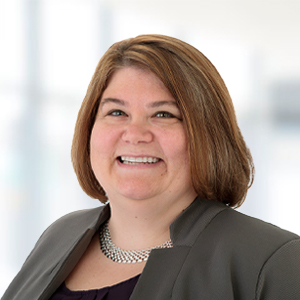“Even with the best-laid plans, the next crisis is always around the corner,” says Becky Rafferty, Vice President of Talent Management at the University of Iowa Center for Advancement (UICA) in Iowa City. And for Iowans in 2020, first it was the pandemic, then months of turmoil and unrest, and next, the derecho.
“Yet our existing plans, structures and strategies that prioritized employee health and well-being helped make what we thought would be challenging decisions during these times much easier,” Rafferty explains.

Here, Rafferty shares the UICA leadership team's action plan to support their employees' mental health, how well it worked and the lessons learned throughout this process.
Create greater access to in-network mental health providers
Rafferty says having broad, in-network mental health coverage helped their 275 full-time employees, ranging from fundraising and information technology to human resources staff, get the help they needed during the pandemic. As a result, they had significantly more employees reach out for mental health support.
"Some employers would say that they don't want their mental health claims to go up that much, and I look at it in a reverse way – if these claims or contacts didn't happen, what would be the result?" she asks.
According to Rafferty, having employees establish a relationship with a mental health therapist avoided a more costly emergency room bill. Because they have that established relationship, she adds, it's that much easier to reach out for support in the future.
And one of the remarkable outcomes from the pandemic is the normalization of telemedicine, especially for mental health, she adds.
"Telemedicine allows for greater access, allowing therapists to see more people throughout the day, and patients are not as likely to cancel their appointments because there’s no need for travel.”
But Rafferty knows these results would have been a lot different had UICA not made in-network mental health coverage a priority several years earlier as part of its strategic plan.
"We switched to HealthPartners because they did a great job reaching out to a handful of providers that weren't in-network, and they brought them on board," she says.
"We discovered that their health plans were much more in line with what we were trying to accomplish, and not just from a mental health perspective but a holistic health standpoint. It wasn't just about paying claims – it was about ensuring our employees are healthy and productive."
Highlight health and well-being resources
Proactively helping their employees stay healthy was an essential part of the UICA's plan.
Before the pandemic, Rafferty and her team relaunched a wellness committee that emphasized physical health, but now there is more focus on mental health. The committee also sends out a weekly Wellness Wednesday digest email to all employees with helpful news articles and information. Having the structure of a wellness committee already in place helped UICA easily communicate health and well-being messaging and connect with their employees during COVID-19.
And many of their communications were about HealthPartners' resources – whether it was Make It OK – Iowa to increase mental health awareness and reduce stigma, myStrength to provide personalized, online cognitive behavioral therapy support or Wellbeats, their online fitness programming.
"HealthPartners did a wonderful job communicating about and offering various wellness activities and resources during the pandemic," Rafferty says. "Our employees loved these tools."
Promote your Employee Assistance Program (EAP)
Another important tool for supporting mental health is an Employee Assistance Program (EAP).
Rafferty says their EAP became one the key resources UICA employees used most often, yet that wasn’t always the case.
“Having an EAP isn't enough – organizations need to promote their EAPs, or else stigma and lack of awareness can lead to few people using them,” she says.
So, Rafferty ensured that anytime anyone had a conversation with the Human Resources (HR) department, even if it was about simple benefits changes, they gave out an EAP card. Thus, the process for talking about the EAP became automatic.
"Before I started at UICA, the HR staff would give EAP information out when they knew someone was struggling, but often by then, when people are making their feelings visible – it's too late," Rafferty explains. "So, we even had to change how we talked about it to reduce stigma and make more people willing to use it. We started positioning the EAP around basic concerns our employees had – whether it be about elder care, legal advice, general wellness, nurse assistance or just helping with the stress in their life. It's become a valuable tool for many to help manage mental health."
And the results have shown just how valuable it has become.
"We have impressive numbers of people using our EAP since the pandemic, and that's important to me because it means that people are not only aware of it now – but they are getting the help they need,” she adds. “And when they may find themselves struggling again in their life, they'll know it's there to provide support."
Align tactics to support leadership language
Beyond promoting resources and offering in-network mental health coverage, the fundamental shift toward creating a healthier workforce happened when we made it a priority to engrain health and well-being into our culture, says Rafferty. And that started at the top – with their leadership and strategic plan.
Guiding statements came out of that work, including: “We make a difference” and “we succeed.”
"But there are two that we have used more in the last 18 months than any others, and those are – 'we care’ and ‘we trust.'"
The statement “we trust” helped guide the decision to let their employees work from home 50% of the time starting in 2018.
"It's been three years now that we've had a work-from-home policy in place, and at the time, we had no idea that a pandemic was on its way," Rafferty says. "So, we had to start encouraging and transitioning our leaders to lean into this culture of trust because this is the culture our employees want. This is the workforce of the future."
These statements also helped Rafferty ensure that all communications throughout the pandemic put their employees first, reflecting their perspective and concerns.
But like so many other employers, Rafferty acknowledges that they didn't have all the answers. Yet she recognized that telling their employees what they do know calmed fears and provided reassurance.
And in these times of crisis, adds Rafferty, these communications created better employee connections and engagement. "Anything that can connect an employee to something that matters most to them leads to better engagement, resiliency and motivation."
Role model behaviors to normalize behavior
Not only did UICA’s tactics align to support the culture of health and well-being, so did the actions of their leaders.
"We talked to our senior leaders, explaining that it's OK to discuss their mental health with their employees," Rafferty explains. "Sharing helps normalize the conversation – it creates a level of vulnerability that's authentic and relatable."
And it sparked the idea to create a dedicated, open, virtual discussion called “Coffee with Leadership,” which gave their employees a chance to ask about challenging issues and their concerns. It was an opportunity to have their voices heard.
Incorporate intentional social times to replace water cooler conversation
With the isolation of working from home and not seeing their colleagues every day, creating more intentional, purposeful periods to socialize and have conversations also helped their employees make deeper connections throughout the pandemic.
"We found that creating intentional social times for our organization was important because our employees enjoy spending time with one another," says Rafferty.
Rafferty’s team had the idea to create "Team Time" – a virtual session where they could get together virtually every week.
"Before we did this, we were stuck on getting through the next crisis, and I didn't even recognize how much I miss my team in that way," Rafferty explains. "We didn't get to hear the funny stories anymore or laugh and simply enjoy each other’s company."
Look to the future and put employees first
At the core of UICA’s strategic plan and COVID planning was the idea of giving their employees as much control back as possible, in a time where it seemed they had little. This meant empowering them to make the decisions that were right for them.
The anecdotal feedback they received from their pandemic planning has been positive.
"People would say in a chat box in a meeting or send emails and say, number one, thank you for being so transparent,” Rafferty says. “Thank you for putting employees first. Thank you for giving us the information, even if you don't know what it is – thank you for being so communicative."
The results of their “putting employees first” philosophy also showed up in their annual employee survey. For the last five years, as part of their strategic plan, they've asked their employees on the survey if UICA is the best place they've ever worked or, in other words, if they are an employer of choice.
And Rafferty says the significant increase in employees saying UICA is the best place they've worked – up from 76% in 2017 to 89% in 2021 – is partly due to the structures they worked so hard as an organization to create.
"My feedback for other employers would be to establish these structures to support employee health and well-being within your culture and leadership so that you do not have to recreate the wheel,” she reveals. “There will always be something around the corner, and being prepared can make all the difference.”
Let HeatlhPartners UnityPoint Health help you measurably improve the mental health, well-being and productivity of your workforce. Through online health and well-being tools, telehealth options and a broad network of providers offered by local health care leader UnityPoint Health, simple, high-quality, affordable care is within reach. And it’s all combined with the coverage and flexibility in small- and large-group fully insured and self-insured plan designs that fit your budget and diverse needs.
